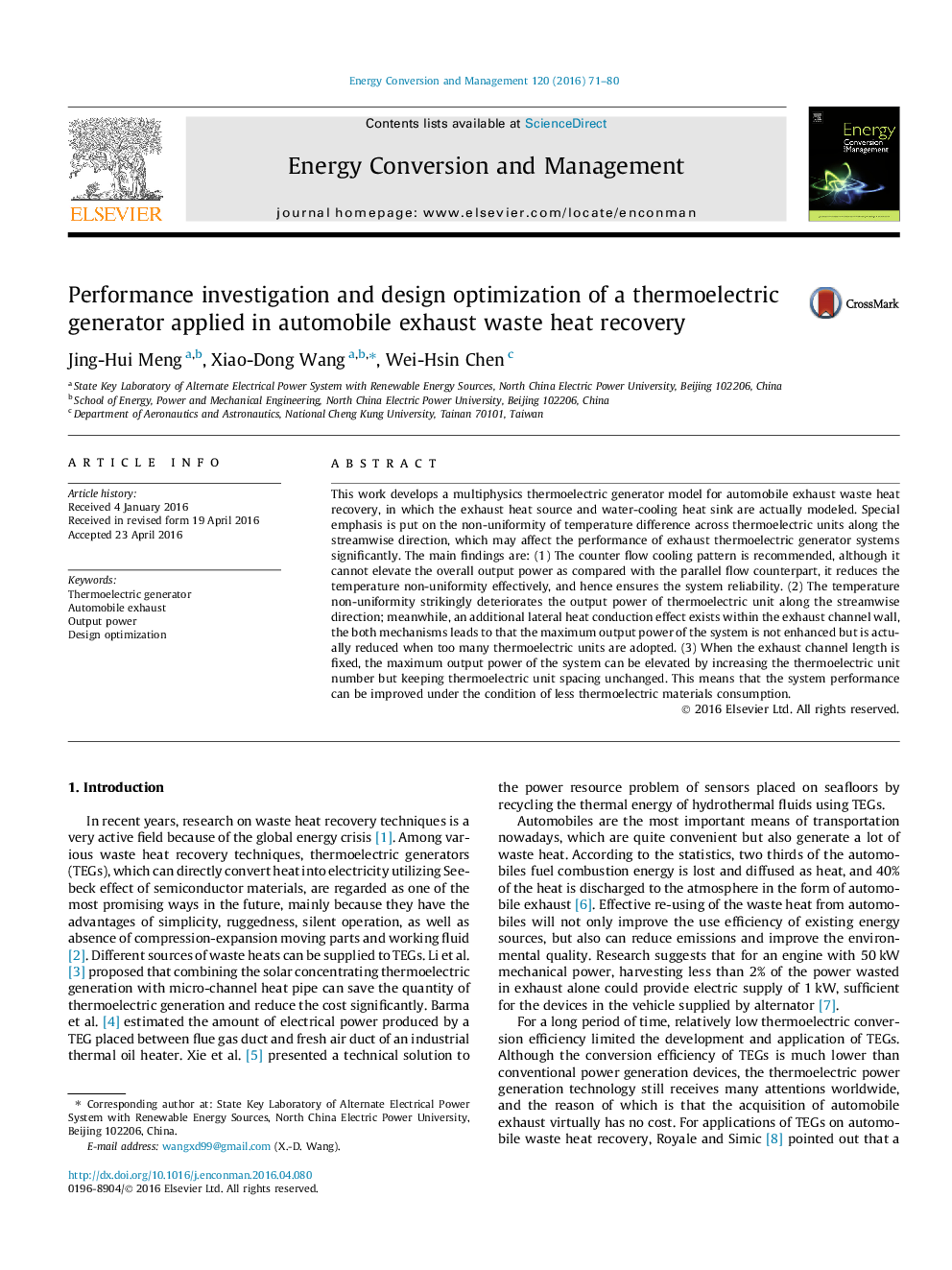| کد مقاله | کد نشریه | سال انتشار | مقاله انگلیسی | نسخه تمام متن |
|---|---|---|---|---|
| 7160456 | 1462842 | 2016 | 10 صفحه PDF | دانلود رایگان |
عنوان انگلیسی مقاله ISI
Performance investigation and design optimization of a thermoelectric generator applied in automobile exhaust waste heat recovery
ترجمه فارسی عنوان
بررسی عملکرد و بهینه سازی طراحی یک مولد ترموالکتریک در بازیابی حرارت بازیافت اگزوز خودرو
دانلود مقاله + سفارش ترجمه
دانلود مقاله ISI انگلیسی
رایگان برای ایرانیان
کلمات کلیدی
ژنراتور ترموالکتریک، اگزوز خودرو، توان خروجی، بهینه سازی طراحی،
ترجمه چکیده
این کار یک مدل ژنراتور ترموالکتریک چند فیزیک را برای بازیابی پسماندهای اگزوز خودرو تولید می کند که در آن منبع گرمای اگزوز و گرمایش آب خنک کننده در واقع مدل سازی می شوند. تاکید ویژه بر عدم تناسب تفاوت دما در واحد های ترموالکتریک در امتداد مسیر جریان است، که می تواند به طور قابل توجهی عملکرد سیستم های ژنراتور ترموالکتریک اگزوز را تحت تأثیر قرار دهد. یافته های اصلی عبارتند از: (1) الگوی خنک کننده ضد جریان توصیه می شود، هر چند که می تواند قدرت خروجی کلی را در مقایسه با جریان مشابه موازی افزایش ندهد، به طور موثر عدم تنوع دمای را کاهش می دهد و از این رو قابلیت اطمینان سیستم را تضمین می کند. (2) عدم تنوع درجه حرارت به طور قابل توجهی قدرت خروجی واحد ترموالکتریک را در جهت جریان جریان می دهد؛ در عین حال اثرات هدایت حرارتی اضافی در دیواره کانال اگزوز وجود دارد، هر دو مکانیسم باعث می شود که حداکثر قدرت خروجی سیستم افزایش یابد اما در صورتی که تعداد زیادی از ترموالکتریک ها تصویب شود، کاهش می یابد. (3) هنگامی که طول کانال اگزوز ثابت می شود، حداکثر توان خروجی سیستم را می توان با افزایش تعداد واحد ترموالکتریک افزایش داد، اما فاصله ی واحد ترموالکتریک را بدون تغییر تغییر داد. این بدان معنی است که عملکرد سیستم را می توان تحت شرایط مصرف کمتر مواد ترموالکتریک بهبود داد.
موضوعات مرتبط
مهندسی و علوم پایه
مهندسی انرژی
انرژی (عمومی)
چکیده انگلیسی
This work develops a multiphysics thermoelectric generator model for automobile exhaust waste heat recovery, in which the exhaust heat source and water-cooling heat sink are actually modeled. Special emphasis is put on the non-uniformity of temperature difference across thermoelectric units along the streamwise direction, which may affect the performance of exhaust thermoelectric generator systems significantly. The main findings are: (1) The counter flow cooling pattern is recommended, although it cannot elevate the overall output power as compared with the parallel flow counterpart, it reduces the temperature non-uniformity effectively, and hence ensures the system reliability. (2) The temperature non-uniformity strikingly deteriorates the output power of thermoelectric unit along the streamwise direction; meanwhile, an additional lateral heat conduction effect exists within the exhaust channel wall, the both mechanisms leads to that the maximum output power of the system is not enhanced but is actually reduced when too many thermoelectric units are adopted. (3) When the exhaust channel length is fixed, the maximum output power of the system can be elevated by increasing the thermoelectric unit number but keeping thermoelectric unit spacing unchanged. This means that the system performance can be improved under the condition of less thermoelectric materials consumption.
ناشر
Database: Elsevier - ScienceDirect (ساینس دایرکت)
Journal: Energy Conversion and Management - Volume 120, 15 July 2016, Pages 71-80
Journal: Energy Conversion and Management - Volume 120, 15 July 2016, Pages 71-80
نویسندگان
Jing-Hui Meng, Xiao-Dong Wang, Wei-Hsin Chen,
